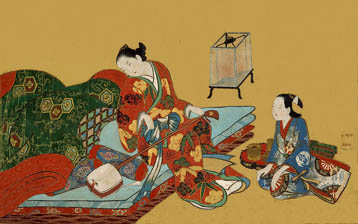Ukiyo-E History 浮世絵(うきよえ)
The brilliant and intimately appealing art of the Ukiyo-e woodblock print is undoubtedly the most universally known of all Japanese arts. This particular style of art flourished in Japan from the mid-seventeenth to the mid-nineteenth century.
Japanese woodblock prints are often referred to as Ukiyo-e. The word Ukiyo-e was originally Buddhist and meant "sad world". By the seventeenth century, however, the meaning evolved to mean, "floating world." The world referred to be one of transient pleasures and freedom from the cares and concerns of the world. The prints and paintings that the merchants commissioned and bought, almost always depicted aspects of a carefree existence, and were therefore called Ukiyo-e: 'pictures of the floating world'.

To understand the prints, and gain respect for the art, we must understand something of the Ukiyo-e, or at least those aspects of it which the print-makers were especially fond of depicting: the theatre, life in the pleasure quarters, and travel. In essence, Ukiyo-e reveals much of the rich history of Japan.
During the sixteenth century in Japan, long-standing wars of rivalry between the feudal lords came to an end and the country was unified. As a result of the peace and unification, the traditional arts experienced a renaissance. The military class, the samurai, began to beautify their castles, which, until that time, had been little more than forbidding fortresses. Painters and sculptures were commissioned to decorate the sliding doors, ceilings and wood panels while weavers and seamstresses were commissioned to produce extravagantly beautiful clothes. Every form of art and craft was vitalized by the desire of the powerful samurai to make their lives as luxurious as possible.
The great merchant families of the cities of Kyoto and Sakai, whose money had provided the samurai with guns and ammunition, also wanted to improve the quality of their lives. Since they were of a lower social order than the military, the merchants did not pretend to be members privy to the aristocratic forms of art, nor to high culture. They commissioned paintings depicting pretty courtesans, visited the new Kubuki dances, and read popular books that were lavishly illustrated by hand. Some of these storybooks were produced as scrolls, some were bound. The demand for these illustrated manuscripts, however, became so great that they could no longer be made by hand. Thus, the picture-book printed from cut wood was born.
Ukiyo-E Continues Utamaro Art Gallery- Ukiyo-E ArtistJapanese Culture and Society Links
Japanese Sports 競技 (スポーツ)
Japanese Food 食品 (しょくひん)
Japanese Pop Culture 文化(ぶんか)
- Hello Kitty Phenomena
- Japanese Anime, Japanese Manga
- Japanese Hair Straightening: All You Ever Wanted to Know
- Kawaii
Miscellaneous
- Creating a Japanese Garden Theme
- Keeping and Handling Japanese Inro
- Misconception about Ninja
- Japanese Bonsai
- Japanese Geisha
- Japanese Wedding
- Why Do Japanese Have Long Lifespan?
- Decorate with Japanese Art
Japanese Literature Links
- Haiku Poetry
- Japanese Alphabet
- Japanese Language
- Japanese Pronunciation
- Learning Japanese Kanji
- Tanka Poems
Japanese Art Links